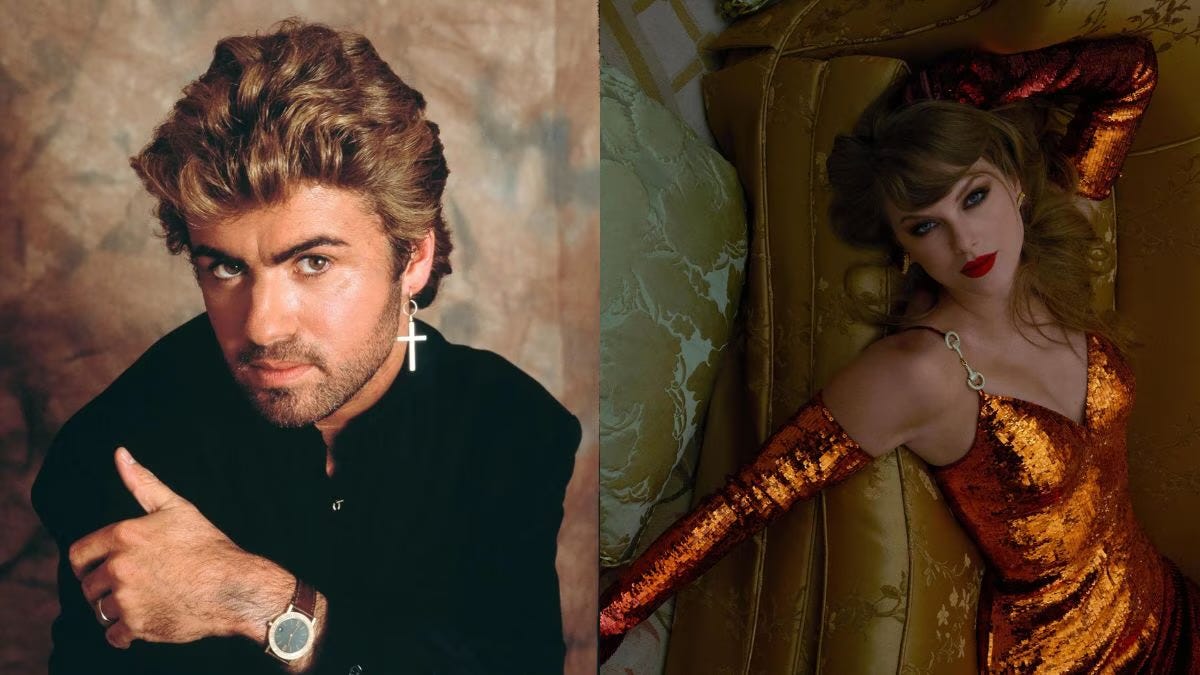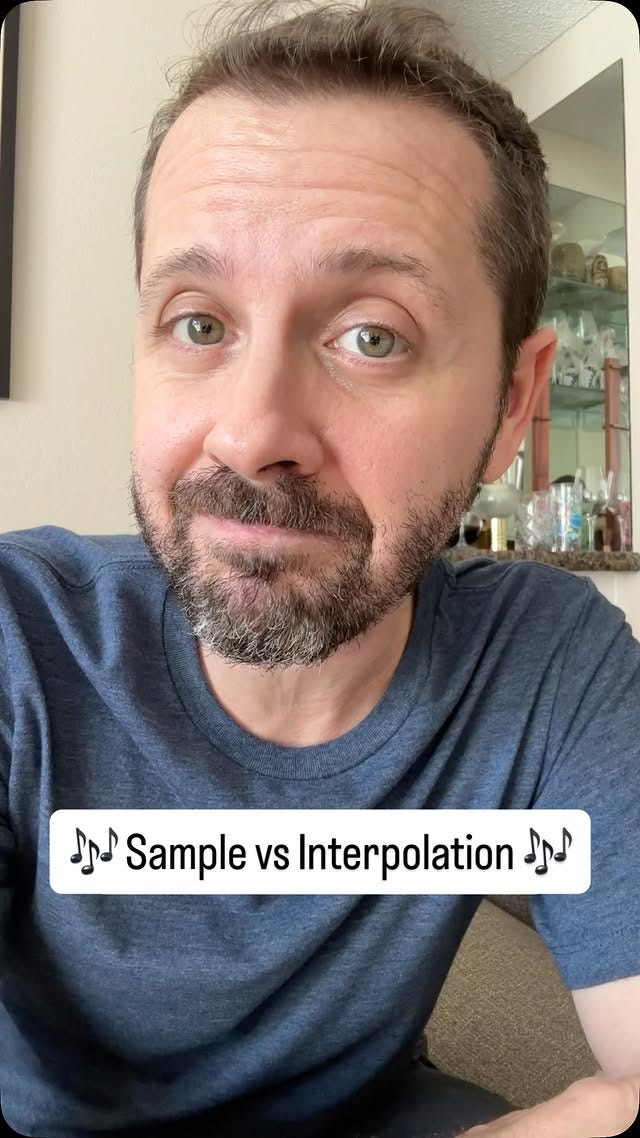What is interpolation...and why has Taylor Swift’s new album started a whole drama about it?
People are confused
Taylor Swift’s latest album, Life of a Showgirl, has caused outrage. From slamming Charlie XCX to using the word ‘dickmatized’ in a song about her fiancé’s appendage, there’s no shortage of backlash online. It’s hardly a surprise. Swift is too big to fail. That must be nice, but it also makes her one of the most reviled characters in pop culture. Her lyrics, musicality, looks, dancing, and general artistry are praised and mocked each time an album is released with a fair amount of predictability.
But Swift probably didn’t expect her latest album to make ‘interpolation’ a TikTok buzzword and bring a rather clunky and academic term first used in the early 1600s into Gen Z and Millennial parlance.
To catch you up, interpolates part of the song Father Figure (1987) by George Michael in her song Father Figure on the latest album, crediting the British icon. But similarities between other songs on the album and various existing songs have caused fans to accuse Swift of ‘interpolating’ other songs without credit for Life of a Showgirl.
But, what is an interpolation?
Interpolation is a term with many meanings. It comes from the Latin word interpolātiōnem, which can be translated as ‘to alter’ or ‘to freshen up’.
In its original usage, the term referred to altering a text with new material.
It also has a mathematical usage. Google tells me it’s ‘the process of finding a new data point within a known set of data points’. But this is a Substack for writers, so this means nothing to us. It has an even more boring computer graphics usage (sorry, graphics nerds).
In music, interpolation means re-recording part of a song and using it in a new song. It can be the melody, lyrics or riff, and it requires a license from the copyright holder if the original is still protected under copyright law.
It’s not the first time Swift has done this. She interpolated the 1991 UK hit I’m Too Sexy for moody revenge song Look What You Made Me Do.
Song you’ll know that use interpolation are:
Beyoncé’s Crazy in Love, which uses the horn riff from The Chi-Lites song Are You My Woman (Tell Me So) released in 1970.
Vanilla Ice’s Ice Ice Baby, which uses the bassline from Queen and David Bowie’s Under Pressure. Despite how unmistakable this similarity is, the rapper still tried to deny it initially.
Ariana Grande’s 7 Rings, released in 2019, was a playful and ironic take on My Favourite Things from The Sound of Music.
Sampling, on the other hand, is taking the original clip. For a simple and conscise explanation with examples, I point you to Mr Cheezy Pop.
When it comes to interpolation, the big debate in music - the one that Swift’s album has prompted is - how similar do two songs have to sound before one is an interpolation of another? That’s a grey area. One Swift and some other artists’ lawyers will have to duke it out to resolve. What I want to talk about is...
Interpolation in fiction
As we know, interpolation started with written texts, long before music beefs.
An interpolation in these ancient texts - not often fictional - was usually something well-intentioned and helpful. The addition of a new discovery, or recently gathered information. Sometimes it was sabotage.
In fiction, interpolation has in different forms. Let’s explore just a few.
Rewriting or continuation
Jean Rhys’ Wide Sargasso Sea famously retells Emily Bronte’s Jane Eyre from the perspective of Bertha Mason, the so-called “madwoman in the attic”. I think we can all agree had certain unanswered questions about this problematic plot twist. The book won many awards, and expands on our understanding of a classic, broadening our perspective, something good interpolations tend to do.
March by Geraldine Brooks tells the story of the absent father from Little Women.
Longbourn by Jo Baker re-imagines Pride and Prejudice from the servants’ view.
James by Percival Everett retells the story of Huckleberry Finn’s journey down the Mississippi River from Jim’s perspective.
Many classics have been rewritten to include the voices of those who were rarely the narrators of history’s most enduring stories.
The embedded tale
The Blind Assassin by Margaret Atwood felt like the most affecting book I had ever read when I put it down. It uses an interpolated narrative, where a shorter narrative is captured in the wider story.
It’s one of the most common forms of interpolation in fiction, but The Blind Assassin is a masterful example. Within the main narrator Iris Chase’s narration, we find her sister Laura’s novel, a story about lovers on a distant planet.
This form of interpolation has been used in well-known novels like Frankenstein and Wuthering Heights and Dracula.
It’s incredibly effective as it forces the reader to piece together the truth at the heart of a story, gathered from different sources.
Interpolator character
This is rare but fascinating use of the device, having a character interpolate another’s narrative.
In House of Leaves by Mark Z. Danielewski, a family’s discovery of a strange space in their house is documented by a blind man. His manuscript is later edited by a tattoo artist struggling with his own demons.
The book, composed of handwritten fragments and footnotes in changing typeface, is a cult classic. It’s also famously hard to read.
These are just three examples of interpolation in fiction. There are many more.
Interpolation is a timeless device used by creatives since the dawn of man, despite not having an its own academic term for most of that time.
Interpolation is a method that allows us to reinterpret the past and to challenge paradigms. And sometimes it just gives us the warm and fuzzies.
In fiction, it gives us new ways of seeing old stories. In music, it gives us the thrill of recognition.
It allows to revisit favourites, and make them our own.
It’s clear the internet is struggling with it. People want art to have clean ownership and clear beginnings.
But it’s never that simple.
As Picasso said, “All art is theft”.
My debut novel, Life of Zanna, is an Insta-whodunit that’s more addictive than your feed.
You can purchase it on Amazon and other indie publishers, and listen on Audible.
My second novel is due to be published summer 2026.




So interesting! I love how you used Taylor's album to then talk about stories, and I especially loved your chronicling of the different ways in which authors can interpolate. You could add fanfic to your list! Not that I read much of it, but there are famous published examples (50 Shades of Grey (Twilight), or the more recent Alchemised (Harry Potter)). The whole article reminded me of McCarthy's quote "books are made out of books," and was a lovely ode to the passionate readers who expand on the stories they love.